MENU
The Electronic Scholarly Publishing Project: Providing access to classic scientific papers and other scholarly materials, since 1993. More About: ESP | OUR CONTENT | THIS WEBSITE | WHAT'S NEW | WHAT'S HOT
Comparative Timelines
The ESP Timeline (one of the site's most popular features) has been completely updated to allow the user to select (using the timeline controls above each column) different topics for the left and right sides of the display.
Select:
New Left Column
New Left Column
Dates
Decade
New Right Column
New Right Column
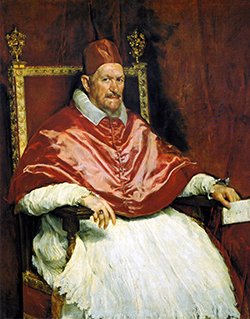 Painting by Diego Velázquez: Portrait of Innocent X is considered by many artists and art critics as the finest portrait ever created. It is housed in the Galleria Doria Pamphilj in Rome. The painting is noted for its realism, in that it is an unflinching portrait of a highly intelligent, shrewd but aging man. He is dressed in linen vestments, and the quality of the work is evident in the rich reds of his upper clothing, head-dress, and the hanging curtains. The pope, born Giovanni Battista Pamphilj, was initially wary of having his portrait taken by Velázquez, but relented after he was given reproductions of examples of Velázquez's portraiture. A contributing factor for this large advancement in the painter's career was that he had already depicted a number of members of Pamphilj's inner court. Yet the pope remained wary and cautious, and the painting was initially displayed to only his immediate family, and was largely lost from public view through the 17th and 18th centuries. The parchment held by the pope contains Velázquez's signature.
Painting by Diego Velázquez: Portrait of Innocent X is considered by many artists and art critics as the finest portrait ever created. It is housed in the Galleria Doria Pamphilj in Rome. The painting is noted for its realism, in that it is an unflinching portrait of a highly intelligent, shrewd but aging man. He is dressed in linen vestments, and the quality of the work is evident in the rich reds of his upper clothing, head-dress, and the hanging curtains. The pope, born Giovanni Battista Pamphilj, was initially wary of having his portrait taken by Velázquez, but relented after he was given reproductions of examples of Velázquez's portraiture. A contributing factor for this large advancement in the painter's career was that he had already depicted a number of members of Pamphilj's inner court. Yet the pope remained wary and cautious, and the painting was initially displayed to only his immediate family, and was largely lost from public view through the 17th and 18th centuries. The parchment held by the pope contains Velázquez's signature.
Irish archbishop James Ussher calculates the date of creation, based on the ages of biblical prophets. Using his calculations, theologians will identify the date of creation as on October 26, 4004 BC.
Tobacco arrives in Africa — European settlers grow it and use it as a currency.
1650
Connecticut legalizes slavery.
William Harvey publishes Exercitationes de generatione animalium (On Animal Generation) explaining that all animal life begins as eggs, whether in birds, amphibians or mammals. According to Joseph Needham, in this work Harvey: (1) presented a doctrine of omne vivum ex ovo (all life comes from the egg), the first definite statement against the idea of spontaneous generation; (2) denied the possibility of generation from excrement and from mud, and pointed out that even worms have eggs; (3) identified the citricula as the point in the yolk from which the embryo develops and the blastoderm surrounding the embryo; (4) destroyed once and for all the Aristotelian (semen-blood) and Epicurean (semen-semen) theories of early embryogeny; and (5) settled the long controversy about which parts of the egg were nutritive and which was formative, by demonstrating the unreality of the distinction.
1651
(no entry for this year)
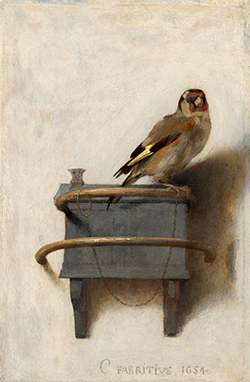 Painting by Carel Fabritius: The Goldfinch is an animal painting by Carel Fabritius of a chained goldfinch. The work belongs to the collection of the Mauritshuis in The Hague, Netherlands. The painting is a trompe-l' il of a European goldfinch (Carduelis carduelis) on top of its feeder that is attached to the wall. The feeder consists of two half rings and a blue container. The bird is sitting on the top ring, to which it is chained by its foot. In the 17th century, goldfinches were popular pets because they could be trained to draw water from a bowl with a miniature bucket. The Dutch title of the painting pertains to the bird's nickname puttertje, which refers to this custom and translates literally as 'little weller'.
Painting by Carel Fabritius: The Goldfinch is an animal painting by Carel Fabritius of a chained goldfinch. The work belongs to the collection of the Mauritshuis in The Hague, Netherlands. The painting is a trompe-l' il of a European goldfinch (Carduelis carduelis) on top of its feeder that is attached to the wall. The feeder consists of two half rings and a blue container. The bird is sitting on the top ring, to which it is chained by its foot. In the 17th century, goldfinches were popular pets because they could be trained to draw water from a bowl with a miniature bucket. The Dutch title of the painting pertains to the bird's nickname puttertje, which refers to this custom and translates literally as 'little weller'.
1652
Massachusetts requires all black and Indian servants to receive military training.
Rhode Island passes laws restricting slavery and forbidding enslavement for more than 10 years.
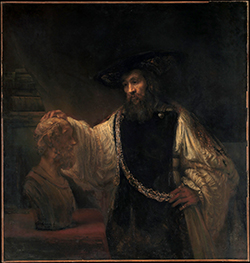 Painting by Rembrandt: Aristotle Contemplating a Bust of Homer was painted as a commission from Don Antonio Ruffo, from Messina in Sicily, who did not request a particular subject. Aristotle, world-weary, looks at the bust of blind, humble Homer, on which he rests one of his hands. This has variously been interpreted as the man of sound, methodical science deferring to Art, or as the wealthy and famous philosopher, wearing the jeweled belt given to him by Alexander the Great, envying the life of the poor blind bard. It has also been suggested that this is Rembrandt's commentary on the power of portraiture.
Painting by Rembrandt: Aristotle Contemplating a Bust of Homer was painted as a commission from Don Antonio Ruffo, from Messina in Sicily, who did not request a particular subject. Aristotle, world-weary, looks at the bust of blind, humble Homer, on which he rests one of his hands. This has variously been interpreted as the man of sound, methodical science deferring to Art, or as the wealthy and famous philosopher, wearing the jeweled belt given to him by Alexander the Great, envying the life of the poor blind bard. It has also been suggested that this is Rembrandt's commentary on the power of portraiture.
Oliver Cromwell dissolves the Rump Parliament and replaces it with the Nominated Assembly (also called the Assembly of Saints or Barebones Parliament.) After three months, the Nominated Assembly passes a motion to dissolve itself and Cromwell establishes the Protectorate.
1653
(no entry for this year)
Scotland incorporated with the English Commonwealth.
 Otto von Guericke invents a vacuum pump consisting of a piston and an air gun cylinder with two-way flaps designed to pull air out of whatever vessel it was connected to, and used it to investigate the properties of the vacuum in many experiments. This pump is described in Chapters II and III of Book III of the Experimenta Nova and in the Mechanica Hydraulico-pneumatica. Guericke demonstrated the force of air pressure with dramatic experiments. In 1657, he machined two 20-inch diameter hemispheres and pumped all the air out of them, locking them together with a vacuum seal. The air pressure outside held the halves together so tightly that sixteen horses, eight harnessed to each side of the globe, could not pull the halves apart. It would have required more than 4,000 pounds of force to separate them.
Otto von Guericke invents a vacuum pump consisting of a piston and an air gun cylinder with two-way flaps designed to pull air out of whatever vessel it was connected to, and used it to investigate the properties of the vacuum in many experiments. This pump is described in Chapters II and III of Book III of the Experimenta Nova and in the Mechanica Hydraulico-pneumatica. Guericke demonstrated the force of air pressure with dramatic experiments. In 1657, he machined two 20-inch diameter hemispheres and pumped all the air out of them, locking them together with a vacuum seal. The air pressure outside held the halves together so tightly that sixteen horses, eight harnessed to each side of the globe, could not pull the halves apart. It would have required more than 4,000 pounds of force to separate them.
1654
A Virginia court grants blacks the right to hold slaves.
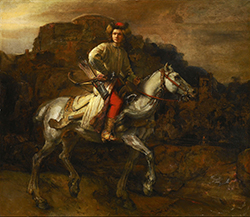 Painting by Rembrandt: The Polish Rider depicts a young man traveling on horseback through a murky landscape. When the painting was sold by Zdzislaw Tarnowski to Henry Frick in 1910, there was consensus that the work was by the Dutch painter Rembrandt. This attribution has since been contested, though this remains a minority view. There has also been debate over whether the painting was intended as a portrait of a particular person, living or historical, and if so of whom, or if not, what it was intended to represent. Both the quality of the painting and its slight air of mystery are commonly recognized, though parts of the background are very sketchily painted or unfinished.
Painting by Rembrandt: The Polish Rider depicts a young man traveling on horseback through a murky landscape. When the painting was sold by Zdzislaw Tarnowski to Henry Frick in 1910, there was consensus that the work was by the Dutch painter Rembrandt. This attribution has since been contested, though this remains a minority view. There has also been debate over whether the painting was intended as a portrait of a particular person, living or historical, and if so of whom, or if not, what it was intended to represent. Both the quality of the painting and its slight air of mystery are commonly recognized, though parts of the background are very sketchily painted or unfinished.
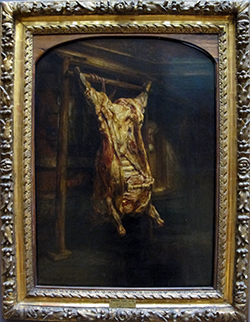 Painting by Rembrandt: The Slaughtered Ox is an oil on beech panel painting by Rembrandt. It has been in the collection of the Louvre in Paris since 1857. A similar painting is in Kelvingrove Art Gallery and Museum, possibly by Rembrandt himself but probably by one of his pupils, perhaps Fabritius. Other similar, paintings attributed to Rembrandt or his circle, are held by museums in Budapest and Philadelphia. The work follows in a tradition of showing butchery, for example Pieter Aertsen's A Meat Stall with the Holy Family Giving Alms and Annibale Carracci's Butcher's Shop. Rembrandt made a drawing of a similar scene c.1635. Another, pre-1655, painting of a slaughtered ox (the example in Edinburgh, now attributed to Rembrandt's circle but formerly to Rembrandt) was perhaps inspired by a lost earlier work by Rembrandt himself. In northern Europe, the month of November was traditionally the season slaughtering livestock in northern Europe, before winter made feed difficult to find.
Painting by Rembrandt: The Slaughtered Ox is an oil on beech panel painting by Rembrandt. It has been in the collection of the Louvre in Paris since 1857. A similar painting is in Kelvingrove Art Gallery and Museum, possibly by Rembrandt himself but probably by one of his pupils, perhaps Fabritius. Other similar, paintings attributed to Rembrandt or his circle, are held by museums in Budapest and Philadelphia. The work follows in a tradition of showing butchery, for example Pieter Aertsen's A Meat Stall with the Holy Family Giving Alms and Annibale Carracci's Butcher's Shop. Rembrandt made a drawing of a similar scene c.1635. Another, pre-1655, painting of a slaughtered ox (the example in Edinburgh, now attributed to Rembrandt's circle but formerly to Rembrandt) was perhaps inspired by a lost earlier work by Rembrandt himself. In northern Europe, the month of November was traditionally the season slaughtering livestock in northern Europe, before winter made feed difficult to find.
The island of Jamaica is captured from the Spaniards by the English.
Danish scholar Ole Worm publishes Musei Wormiani Historia, a successful book about his cabinet of natural curiosities.
1655
(no entry for this year)
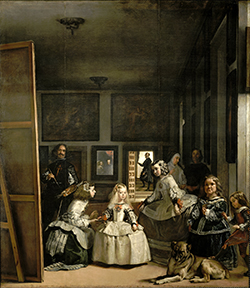 Painting by Diego Velásquez: Las Meninas (The Ladies-in-Waiting) has a complex and enigmatic composition that raises questions about reality and illusion, and creates an uncertain relationship between the viewer and the figures depicted. Because of these complexities, Las Meninas has been one of the most widely analyzed works in Western painting. The painting shows a large room in the Royal Alcazar of Madrid during the reign of King Philip IV of Spain, and presents several figures, most identifiable from the Spanish court, captured, according to some commentators, in a particular moment as if in a snapshot. Some look out of the canvas towards the viewer, while others interact among themselves. The young Infanta Margaret Theresa is surrounded by her entourage of maids of honour, chaperone, bodyguard, two dwarfs and a dog. Just behind them, Velázquez portrays himself working at a large canvas. Velázquez looks outwards, beyond the pictorial space to where a viewer of the painting would stand. In the background there is a mirror that reflects the upper bodies of the king and queen. They appear to be placed outside the picture space in a position similar to that of the viewer, although some scholars have speculated that their image is a reflection from the painting Velázquez is shown working on. Las Meninas has long been recognised as one of the most important paintings in Western art history. The Baroque painter Luca Giordano said that it represents the "theology of painting" and in 1827 the president of the Royal Academy of Arts Sir Thomas Lawrence described the work in a letter to his successor David Wilkie as "the true philosophy of the art". More recently, it has been described as "Velázquez's supreme achievement, a highly self-conscious, calculated demonstration of what painting could achieve, and perhaps the most searching comment ever made on the possibilities of the easel painting".
Painting by Diego Velásquez: Las Meninas (The Ladies-in-Waiting) has a complex and enigmatic composition that raises questions about reality and illusion, and creates an uncertain relationship between the viewer and the figures depicted. Because of these complexities, Las Meninas has been one of the most widely analyzed works in Western painting. The painting shows a large room in the Royal Alcazar of Madrid during the reign of King Philip IV of Spain, and presents several figures, most identifiable from the Spanish court, captured, according to some commentators, in a particular moment as if in a snapshot. Some look out of the canvas towards the viewer, while others interact among themselves. The young Infanta Margaret Theresa is surrounded by her entourage of maids of honour, chaperone, bodyguard, two dwarfs and a dog. Just behind them, Velázquez portrays himself working at a large canvas. Velázquez looks outwards, beyond the pictorial space to where a viewer of the painting would stand. In the background there is a mirror that reflects the upper bodies of the king and queen. They appear to be placed outside the picture space in a position similar to that of the viewer, although some scholars have speculated that their image is a reflection from the painting Velázquez is shown working on. Las Meninas has long been recognised as one of the most important paintings in Western art history. The Baroque painter Luca Giordano said that it represents the "theology of painting" and in 1827 the president of the Royal Academy of Arts Sir Thomas Lawrence described the work in a letter to his successor David Wilkie as "the true philosophy of the art". More recently, it has been described as "Velázquez's supreme achievement, a highly self-conscious, calculated demonstration of what painting could achieve, and perhaps the most searching comment ever made on the possibilities of the easel painting".
The first persecution of Quakers occurs in Massachusetts.
1656
(no entry for this year)
(no entry for this year)
1657
Virginia passes a fugitive slave law.
Cromwell dies and his son Richard becomes Lord Protector.
Jesuit missionary Martino Martini publishes a manuscript explaining that documented Chinese history predates the time generally understood to mark Noah's flood (2,300 BC).
1658
(no entry for this year)
Richard Cromwell is pressured into dissolving the Protectorate; the Rump Parliament is restored.
John Tradescant deeds his family treasures to fellow collector Elias Ashmole. Ashmole will later donate the collection to Oxford University, stipulating that a separate building is to be constructed for it.
1659
(no entry for this year)
ESP Quick Facts
ESP Origins
In the early 1990's, Robert Robbins was a faculty member at Johns Hopkins, where he directed the informatics core of GDB — the human gene-mapping database of the international human genome project. To share papers with colleagues around the world, he set up a small paper-sharing section on his personal web page. This small project evolved into The Electronic Scholarly Publishing Project.
ESP Support
In 1995, Robbins became the VP/IT of the Fred Hutchinson Cancer Research Center in Seattle, WA. Soon after arriving in Seattle, Robbins secured funding, through the ELSI component of the US Human Genome Project, to create the original ESP.ORG web site, with the formal goal of providing free, world-wide access to the literature of classical genetics.
ESP Rationale
Although the methods of molecular biology can seem almost magical to the uninitiated, the original techniques of classical genetics are readily appreciated by one and all: cross individuals that differ in some inherited trait, collect all of the progeny, score their attributes, and propose mechanisms to explain the patterns of inheritance observed.
ESP Goal
In reading the early works of classical genetics, one is drawn, almost inexorably, into ever more complex models, until molecular explanations begin to seem both necessary and natural. At that point, the tools for understanding genome research are at hand. Assisting readers reach this point was the original goal of The Electronic Scholarly Publishing Project.
ESP Usage
Usage of the site grew rapidly and has remained high. Faculty began to use the site for their assigned readings. Other on-line publishers, ranging from The New York Times to Nature referenced ESP materials in their own publications. Nobel laureates (e.g., Joshua Lederberg) regularly used the site and even wrote to suggest changes and improvements.
ESP Content
When the site began, no journals were making their early content available in digital format. As a result, ESP was obliged to digitize classic literature before it could be made available. For many important papers — such as Mendel's original paper or the first genetic map — ESP had to produce entirely new typeset versions of the works, if they were to be available in a high-quality format.
ESP Help
Early support from the DOE component of the Human Genome Project was critically important for getting the ESP project on a firm foundation. Since that funding ended (nearly 20 years ago), the project has been operated as a purely volunteer effort. Anyone wishing to assist in these efforts should send an email to Robbins.
ESP Plans
With the development of methods for adding typeset side notes to PDF files, the ESP project now plans to add annotated versions of some classical papers to its holdings. We also plan to add new reference and pedagogical material. We have already started providing regularly updated, comprehensive bibliographies to the ESP.ORG site.
ESP Picks from Around the Web (updated 06 MAR 2017 )
Old Science

Weird Science

Treating Disease with Fecal Transplantation
Fossils of miniature humans (hobbits) discovered in Indonesia

Dinosaur tail, complete with feathers, found preserved in amber.
Astronomy

Mysterious fast radio burst (FRB) detected in the distant universe.